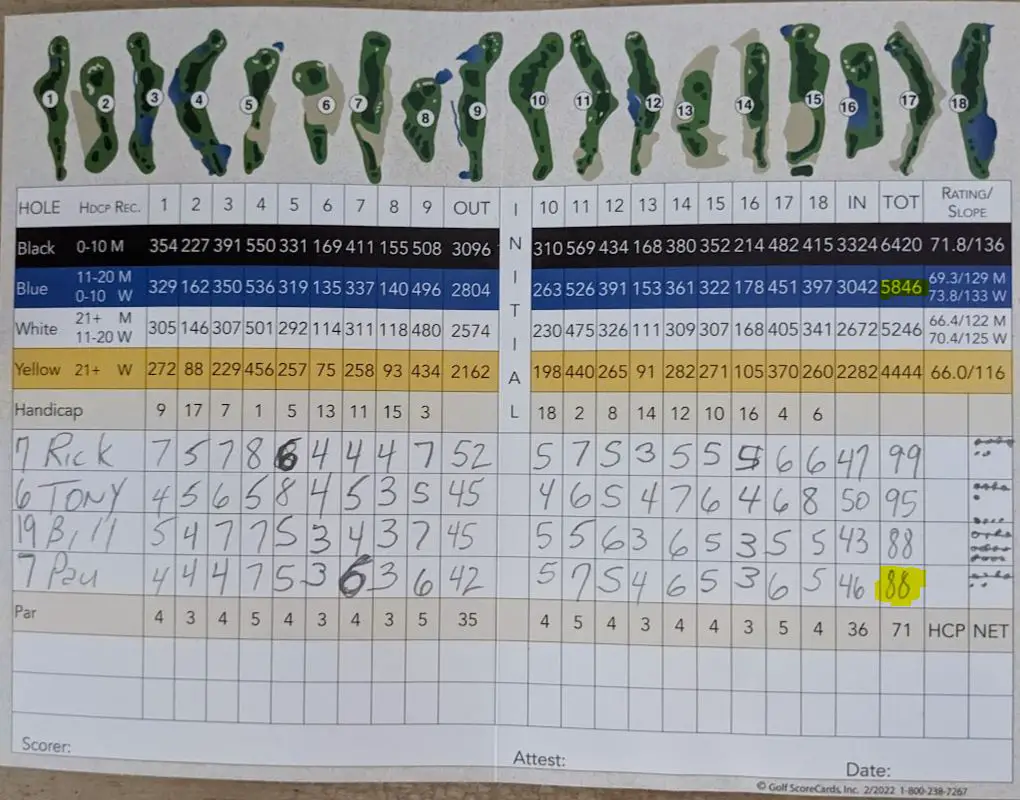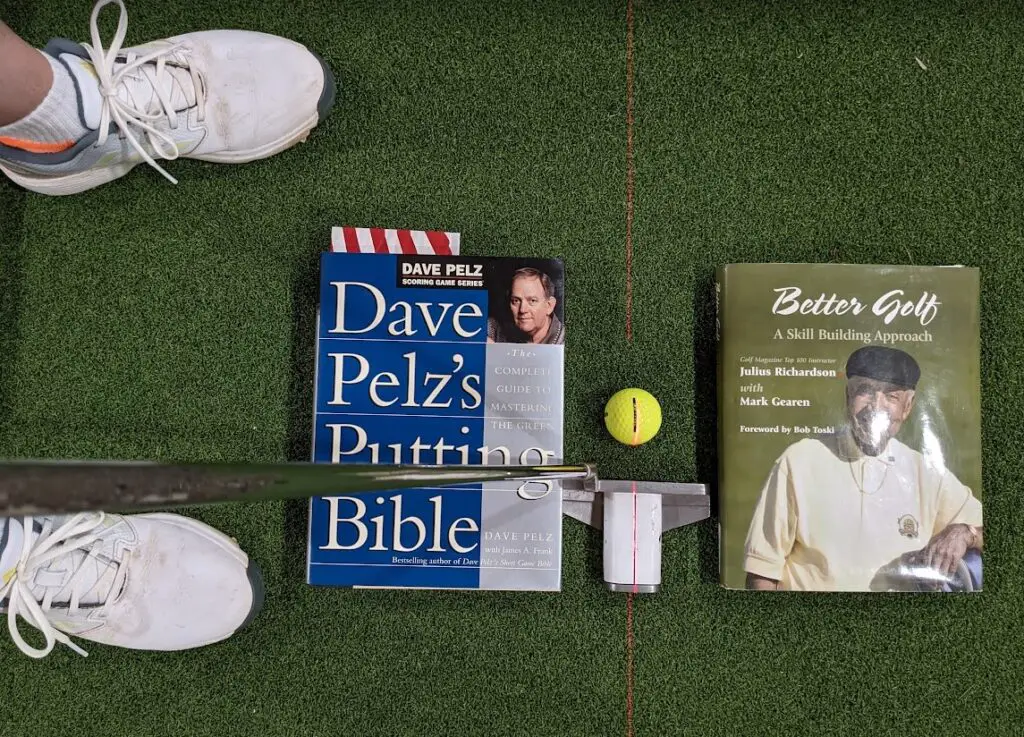I was there for many years. Struggling at first many years ago to break 100 until I reigned in a little bit of accuracy. I’ll share some tips that I picked up in how to break 90 in golf that came from both instructors as well as on course management. The simplest tip may be just a calculation which lets you look at which tee box is best for you. Now it doesn’t mean you will always be playing from the white tees or the gold tees but this is a great starting point.
Tip 1 Use The Correct Tee Box
The number one tip I could give is to play from the appropriate tees. What? Yes, if you are anything like me and some of the friends I play with, they like to play from the back tee box. So whether that is black or blue, whatever makes the course the longest is what they choose to play. Do you want to know how to break 90 in golf? Yes, this is the first tip and it comes with a formula. Take your average 5 iron distance and multiply it by 36. For me, I don’t use a 5 iron but my 6 hybrid distance equates to the 5 iron and I average 170 yards with the 6 hybrid. So the calculation would look like this:
170
x 36
——-
6,120
With the above formula, I should be playing tees up to 6,120 in length. Looking at the scorecard below, I played the blue tees. This is a relatively short course as compared to some I play but it gives an example of what tee box you should be hitting from. I did break 90 on this course although I did not play that spectacularly. I can test this theory inside my golf simulator by playing a course from the white tees and then playing the same course from the blue tees. With good course management, I am typically a few shots better simply by playing the shorter golf course.

Tip 2 Make sure you warm up
Make sure you warm up. This really should go without saying. I’m talking both at the range swinging with a variety of clubs to set distances and targets (more on that in another post) and on the putting green. I break the “at the range” rule quite a bit but I do make sure to get warmed up with my practice swings as well as time putting and sometimes chipping.
Personal experience: I may not have paid this much attention but a couple of friends mentioned it. I was told I hit longer and longer drives as the round went on. I started to pay attention to what they were saying. I would step up to the first hole and hit a 185-190 yard drive because I wasn’t warmed up. By the time the 15th hole rolled around, I was hitting it 225 yards or further. If nothing else (and I now always practice putting for about 10 minutes), I will get a good 30 swings in before hitting the first tee box. In that way, my 80mph driver clubhead speed was now getting up past 85mph and approaching 90mph.
Moral of the story. Don’t give up yardage because you aren’t warmed up.
Tip 3 Practice From 100 Yards In
100 yards in. Besides putting, where do most of your shots take place? For me, it is within 100 yards of the green. So for the vast majority of these type of shots, you are probably using two or three different clubs. At 100 yards in I am using a 60 degree lob wedge and approach wedge.
I recommend keeping track of greens in regulation (GIR). Not trying to take the fun out of the game but purely from a data or numbers standpoint. If you start to keep track of the number of fairways hit, greens in regulation, and number of putts, you will have a starting point to know where you may need to improve. My recommendation is to do this over 3-5 rounds. I needed help in all of these categories.
If you access to a net with a launch monitor or perhaps a full blown Skytrak Golf Simulator, you can practice these types of shots from the comfort of your home, shed, or garage. For example, hit 10 shots each at 40 yards, 60 yards, 80 yards, and 100 yards. Keep track of the number of yards dispersion and have a game to improve on the previous practice performance numbers, either distance wise or hitting towards a flag.
Tough for an amateur to sometimes get through their head but when hitting a shot towards the longer distance of close to 100 yards, go for the middle of the green while trying to steer clear of bunkers. As you get closer to the green you can be more target oriented but for now improve your greens in regulation by going for the center of the green.
Tip 4 Forgo Wedges Close To The Green
Chipping and wedges within 10 yards of the green. I learned my lesson here. My 60 degree wedge is basically my 75 yards in club. When you only hit a few greens per round your golf ball is typically scattered somewhere around the green. That 60 degree wedge, well I learned to thin it so often that it was a given I would give up a couple of shots per round when chipping with that club.
What I learned is to scrap my 60 degree wedge when around the green and to typically chip using between an 8 iron or sometimes a 7 iron instead. Depends how much roll I want to get. This allows for a nice bump and run. Previously I was thinking of hitting the lofted 60 degree, let it bounce a couple of times and stop. That hardly ever worked for me. If you pick a spot where you want to land, the bump and run with an 8 iron or even 7 iron works great.
Old Man Pat will give a little tip within the first four and a half minutes of this video. Honestly, this entire video is a classic. Take some time out and give it a watch.
Tip 5 Don’t Put Yourself In Trouble
Don’t put yourself in trouble. Have a shot that has ended up in the trees and you see a short gap to hit through? Don’t be like the golfer scoring 100 today while he or she tries to hit through the trees. Instead, find an opening with plenty of room where you can punch out. Why let one bad shot turn into two or three shots added to your score. You watch professionals punch out sometimes and there is a reason for it.
Have a lake that is 160 yards to the front and you would need a 200 yard shot to get over? Sure, I can hit my 3 wood 210 yards and my 3 hybrid 200 yards but that is typically with a nice roll. Do yourself a favor and hit an easy 8 iron 140 yards out. Then your next club will be an easy shot over the water.
Tip 6 Putt For Dough
Across the board and no matter the handicap, the typical golfer averages about 40% of his or her shots using the putter. The difference is that the average amateur might take about 40 putts per round while the professional averages 32 putts per round. I just watched Cameron Smith over this past weekend and decided to check out how many putts he averages. Approximately 28 putts per round and there was that time he took 18 putts in a single round. Incredible!
Depending on the time of year or ability to make it to the golf course, let’s look at an indoor drill if our task at hand is how to break 90 in golf.
Putting Training Aids
I am a firm believer in tools or golf training aids if you have a little bit of expendable cash. For instance, recently I watched Cameron Smith use a Pro Path Putting Mirror. I have seen other professionals using the EyeLine Golf Groove Putting Mirror. The idea is to be able to get to a point where you are controlling your setup and path. These products can be used either outdoors or indoors. For indoor use I have a simple putting mat that is approximately 9 feet long.
Don’t care to purchase a putting aid? That’s ok. Let’s use some items we can find around the house. How about a couple of golf books? Set up the golf books so you can barely get your putter through from side to side. Either put a yardstick, some tape, or do what I did as you can see in the picture below, and put a laser down the middle of the ball and putter.

If nothing else, throughout the off-season practice 100 putts at a time. You will be amazed at any unsteadiness you may have dealt with in the past as compared to your new putting stroke. What I recommend is putting to varying distances. So pick a spot 3 feet away and make 20 putts, then pick a spot 6 feet away and make 20 putts, etc…
As an added twist, putt with only the right hand using the same method as above. Then do the same with the left hand. If it is too difficult to continue using books while using one hand, remove the books but still concentrate on having a well-aligned stroke backwards and through.
How To Break 90 in Golf Final Conclusion
I’ll go back to the number one tip and highly recommend playing a tee box that is within a yardage suitable to your game. As some of my friends have grown older unfortunately they have lost distance. Another friend has a shoulder injury but otherwise can play some great golf. Don’t set yourself up for failure by playing from the long tees. If nothing else, use the calculation above and see what it is like to play from the correct tees once.
Maybe check out that video from Old Man Pat another time. A gentleman who does not hit the ball far but by playing smart can shoot some great scores.
Wishing you all the best and let me know how you get on. Feel free to leave comments below.

